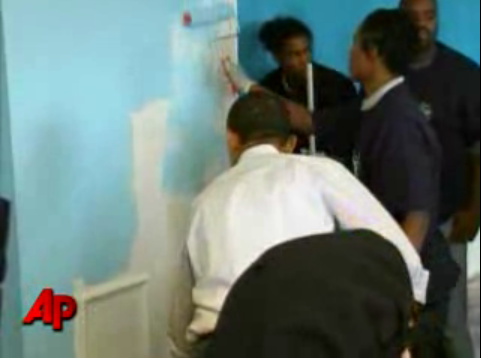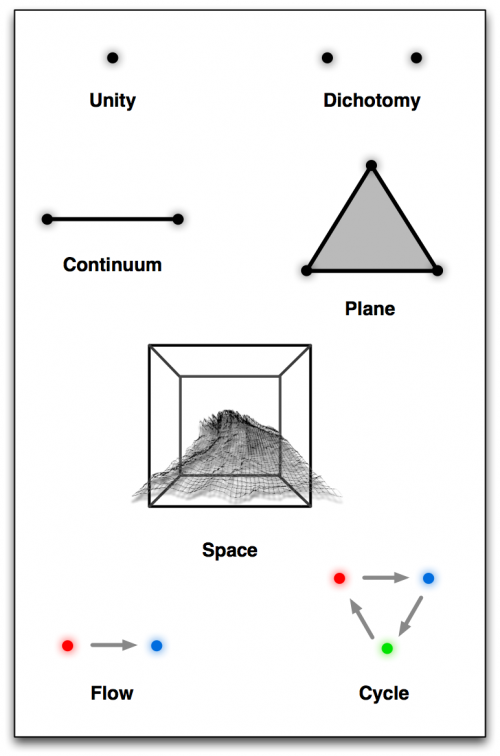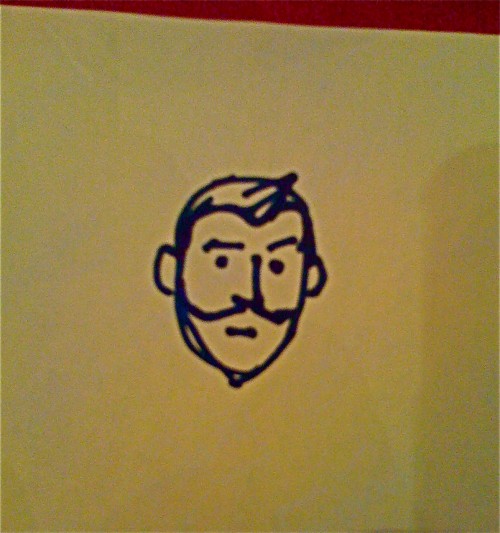Two videos for February 1st
The first day of February was warm and coming back from Super Bowl snack-shopping, I shot some videos. Enjoy.
Two videos for February 1st
The first day of February was warm and coming back from Super Bowl snack-shopping, I shot some videos. Enjoy.
Types of Facilitator Interventions
Flipping through The Facilitator’s Fieldbook (Second Edition) I really liked their listing/categorization of the different Types of Process Consultation. It’s a straighforward breaking apart of the different methods one might use to facilitate an interaction (normal-speak translation: talk to people)
- Active Listening: Paying close attention to both what is being said and the processes that are occurring, leading to highlighting clarification, summarizing, and consensus building.
- Inquiry: Questions and probes to raise data, focus attention, and/or stimulate diagnostic thinking; surfacing data for the group to look at.
- Observation and feedback: Seeing what is going on with an individual or the group and then (a) describing in behavioral terms what they are doing; (b) reflecting their emotional state; and (c) interpreting the underling dynamics of what is going on.
- Concretization: Pushing people to be concrete and specific to get beyond generalizations.
- Historical reconstruction : Looking back over events to force a reconstruction and review of what was done and how it was done (emphasizing the process dimensions).
- Including process focus: Building in process analysis periods, feedback sessions, and process discussions.
- Cognitive inputs: Concepts or ideas shared with the group to help members understand something.
- Skill building: Interjecting brief learning activities to enhance the capabilities of the group members in some needed competency (e.g., feedback, problem solving).
- Counseling/guidance: Helping the group or individuals look at themselves and actively engage in solving their own problems
- Designing processes: Designing and managing activities, methods, or exercises to effectively reach desired outcomes.
- Structural alternatives: Suggesting options for group membership, subgroups, interaction patterns, work allocation, roles and responsibilities, and so forth.
- Content suggestions or recommendations: Providing input or opinions concerning the content the group is working on; recommending what the group should do about some aspect of the group’s content.
The book also breaks out some other dimensions of your interaction:
| Non-directive | <—> | Directive |
| Cognitive | <—> | Emotional |
| Reflective (Diagnostic) | <—> | Active (Doing) |
| Exploratory | <—> | Confrontative |
| Participating alongside the group | <—> | Participating in the group |
American Commissar: my family archive project
It’s been about 3 years since I started and I’m excited to finally be rolling out a digital version of my late grandfather’s autobiography, American Commissar. The book follows my grandfather from Hungary to America as an immigrant in the 1920s; his entrance to the communist party and their activities during the 1920s and 30s; his wartime experiences serving with the Abraham Lincoln Brigade in the Spanish Civil War; and his frustration and disillusionment with the international Soviet communist movement. The book is human, funny, and—my grandfather being an accomplished playwright—well-paced with memorable scenes and stories. Seriously.
I will be posting one chapter from the book each week—there are 60 total plus an epilogue—on a blog specially set up for the purpose: http://americancommissar.wordpress.com
While I would not characterize the past 3 years as “steady progress” towards my goal of fully digitizing the book, I’m really happy to be entering the finale. The book itself is nearly 500 pages—which I have been scanning, converting to text (OCR) and proof-reading against the original text. Published in 1961, my family is pretty sure the book has entered the Public Domain—my mom and I have researched the laws (yuck), as well as contacting the original publisher and Adelphia University, who maintains his archive. When I’m finished I’ll be submitting the entirety to Project Gutenberg.
In addition to my own personal interest in the work, I think the book has enduring lessons. As a 2nd generation American citizen, the experience of confused immersion and material poverty is so distant; as is the experience of the early-20th century, which few history books expose from such unique points of view. Fighting against the Fascists during the Spanish Civil War, my grandfather would today have been classified as an “unlawful combatant” or terrorist; yet at the time was cheered both locally and abroad. Most enduringly, I think his view of community organizing and his experience with the American Communist Party at the time is profound: the radical populism of the American Communist Party was one of the few movements actively advocating for the social services we take for granted today like Medicare, Social Security and unemployment insurance. As my grandfather argues, it was these evolutionary reforms that protected the American way of life (enduring freedom and opportunities) from Soviet style revolution—a movement that at its end my grandfather became disillusioned with and he worked the rest of his life to distance himself from.
While the book is a harsh critique of the Communist Party, I think my grandfather’s hope, optimism, and well-intentioned desire for positive change—topical concepts for today—are the book’s strongest themes; though I admit I am of a much different generation than both my parents and my grandfather’s contemporaries.
So I hope you will subscribe to the blog and read my grandfather’s book at http://americancommissar.wordpress.com
Obama Painting

Using distinctions to create meaning
For Christmas, my friend Danielle bought me the book, The Tree of Knowledge: The Biological Roots of Human Understanding. It’s getting a little long in the tooth near page 150, but I really like how they go about building up their argument. Specifically, how they define Destinctions.
I’ve been accused in the past (by my own mom, for one) of being semantic. Well, this is all of semiotics (of which semantics is just one part, along with syntactics and pragmatics). So too bad.
The book builds upon the idea of “knowing how we know” and argues from the basic standing that “all doing is knowing and all knowing is doing” or “everything said is said by someone”. They begin with the point that in creating knowledge, we are performing an act of Distinction: separating something from its background based upon certain criterion. This something (being, object, concept, etc), is called a Unity. Conversely, each time we refer to something (a Unity) in conversation, we are performing an act of Distinction. A unity can be anything from a person, to a species, to an object, to a color, to an emotion, to a concept, to 1 of 100 different names for snow (which is an urban legend, by the way.
I found that to be an incredibly interesting way of breaking down understanding. Building upon the core idea of Unity, I wanted to propose some additional building blocks of meaning that are commonly used in conversation, rhetoric and didactics (and easily found elsewhere on this blog).

A Dichotomy is choosing between two unities that are mutually exclusive. Dichotomies (and false dichotomies) are easily used and abused in arguments and rhetoric—some go so far as to say the West is an Argument Culture where middle alternatives are ignored.
A Continuum is a linear series capped by two Unities. Sometimes there is meaning along the line, but the meaning primarily is a function of proximity to one unity or the other. Probability is a simple continuum, capped at one end by absolute certainty, and absolute non-certainty at the other.
A Plane (or Field) is an flat-area bounded by multiple unities. Creating meaning from one’s position within the plane becomes more difficult to communicate unless in close proximity (or far distant) to a unity.
A Space is the most complex construction of meaning in which many unities are “mapped” out. For such a construction, pointing out significant features (low-points, high-points, etc.) are the only way to communicate meaning about a space.
Ending with spaces, it’s interesting to note that the realm of human understanding (as bounded by our senses and cognition) is still a simplification of the complete space of possibility. Even so, simpler and simpler constructions are made in order to successfully communicate.
Of course, definitions need not be static. Because of that, I propose two ideas of movement or state change. Flow is the change from one state of unity to another; a meta-dichotomy. A frog may flow through the states of egg, tadpole, and adult. A Cycle is a flow that iterates multiple times.
And for recursions sake, by defining these concepts, or applying these definitions to something, we are performing an act of distinction.
Patterns of Meaning
I am also convinced, but cannot prove, that there are no objects, but only relations. By this I mean that I am convinced that there is a consistent way of thinking about nature that refers only to interactions between systems and not to states of or changes in individual systems. I am convinced that this way of thinking of nature will end up to be the useful and natural one in physics. Carlo Rovelli, physicist, Institut Universitaire de France and Université de la Mediterranée; author of Quantum Gravity. Edge Foundation
Archetypes of history
Great man theory, etc.
2008 in Review

To follow up on last year’s navel gazing, here’s the roundup for 2008:
Places I’ve Slept:
California: Santa Barbara, San Luis Obispo, Los Angeles, Poway;
Northwest: Seattle, CA; Portland and Silver Falls, Oregon;
Midwest: Denver, CO; Madison, WI;
South: New Orleans, LA;
East: Jersey City, NJ; Narragansett, RI;
Best Purchase: Jose Pierpont
Best Gift: Buttons
Best Book: PopCo by Scarlett Thomas
Best Album: Cloud Cult’s The Meaning of 8
Best Object: Butcher block kitchen table that has become my desk
Best Shoe: Dansko clogs
Best Project Brompt.com
Weingarten Rights
I found my union card today and with it was a little Weingarten Rights card—explaining my right to have union representation during an interview by my employer. I didn’t particularly like the text of it, so this is from Wikipedia:
RULE 1: The employee must make a clear request for union representation before or during the interview. The employee cannot be punished for making this request.
RULE 2: After the employee makes the request, the employer must choose from among three options. The Employer must either: grant the request and delay questioning until the union representative arrives and has a chance to consult privately with the employee; deny the request and end the interview immediately; or give the employee a choice of having the interview without representation or ending the interview.
RULE 3: If the employer denies the request for union representation, and continues to ask questions, it commits an unfair labor practice and the employee has a right to refuse to answer. The employer may not discipline the employee for such a refusal.
In 2000, Weingarten Rights were extended to non-union employees (in the form of the right to have a coworker present during investigatory meetings). This was later rescinded in 2004.
Some protected activities still do exist for non-union employees:, including:
- Free To Discuss Discipline, Wages and Benefits
Non-union employers cannot prohibit employees from discussing work conditions, wages or discipline. In Double Eagle Hotel & Casino, an employer violated the NLRA by promulgating a work rule that prohibited employees from sharing such information with each other or persons outside the company. Such a rule, according to the Board, “plainly infringes on upon Section 7 rights.”
- Email Complaints About Company Policies
Non-union employers cannot terminate employees for sending mass emails complaining about new company policies. An employee’s “effort to incite other employees to help him preserve a vacation policy which he believed best served his interests, and perhaps the interests of other employees, unquestionably qualified his communication as being in pursuit of mutual aid or protection.” Even if the email does not request other employee participation and is sarcastic in nature, such communications remain protected under the NLRA.
- Non-Union Employees Are Free to Walk Off The Job To Complain About Supervisors or Other Job Conditions
Another common trap is when non-union employees walk off a job to protest certain job conditions. Most employers naturally (but incorrectly) presume that they may terminate non-union employees for abandoning the job. But that is not always the case. If, for example, employees engage in a work stoppage due to a legitimate job complaint, the NLRA may protect such conduct. In Trompler, Inc., an employer was held liable for back pay and reinstatement for terminating six employees who walked off the job in response to unanswered complaints about their supervisor.Such a work stoppage may qualify as “protected concerted activity” under Section 7 of the NLRA.
Human Measurements
Great comment from slashdot on English Units:
A league is about the distance a healthy man can walk on a good road in one hour. A fathom is about the height of a tall man; it is about eighteen hand widths (fingers closed). A US gallon is the volume of eight pounds of water. An imperial gallon (i.e. the UK gallon) is the volume of ten pounds of water.
One interesting thing about weights. The system of dram/ounce/pound is base 16, which makes division by two a practical measuring operation. Take a pound of something readily dividable, divide it into two equal portions (using a balance scale). Then repeat the process four times. The result is one ounce.
This shows the offsetting virtues of traditional units. While they are difficult to calculate with, they are convenient for measuring things – especially when it come to quantifying things for sale.
For example, consider length:
1 inch = approximately the width of a thumb
1 hand = 4 inches = width of a hand with fingers closed
1 ft = 3 hands
1 yard = 3 ft
1 fathom = 2 yards
1 rod = 5.5 yards = length of ox goad
1 chain = 22 yards = 100 links in standard survey chain
1 furlong = 10 chains = distance ox team can plow without rest
1 mile = 880 fathoms
Notice that if you lay out a square field such that an ox team can plow one furrow across then rest, you get a square with sides of exactly one furlong or 660 ft. The area of that field 43,600 square feet, which is nearly exactly one acre (43,560 ft).
For purposes of round measurement (no fractions), such as you would use in commerce, traditional measurement is far more convenient. If I’m buying liquor, the following units exhaust all the practical measures to which I might wish to round a purchase:
1 mouthful
1 jigger (aka 1 fluid ounce) = 2 mouthfuls
1 jack = 2 jiggers
1 gill = 2 jacks = 4 jiggers
1 cup = 2 gills = 8 jiggers = 16 mouthfuls
1 pint = 2 cups
1 quart = 2 pints = 4 cups
1 gallon = 4 quarts = 8 pints = 16 cups
1 cask = 16 gallons
1 barrel = 2 casks
1 hogshead = 2 barrels
1 butt = 2 hogsheads = 4 barrels
1 tun = 2 butts = 4 hogsheads = 8 barrels
In such a system of measurement, you never, ever have to deal with fractions. Breaking down into smaller units is simply a matter of dividing a whole into two equal parts. So if you want to buy things without having to specify fractions, traditional units are the bee’s knees (equal to 1 / 128 of an inch … no just kidding). That’s not so important in a world with calculators – you just calculate a unit price.
Still, if you want to buy eight feet, three inches of rope, you can measure out twenty-four hands and three thumbs and come rather close.